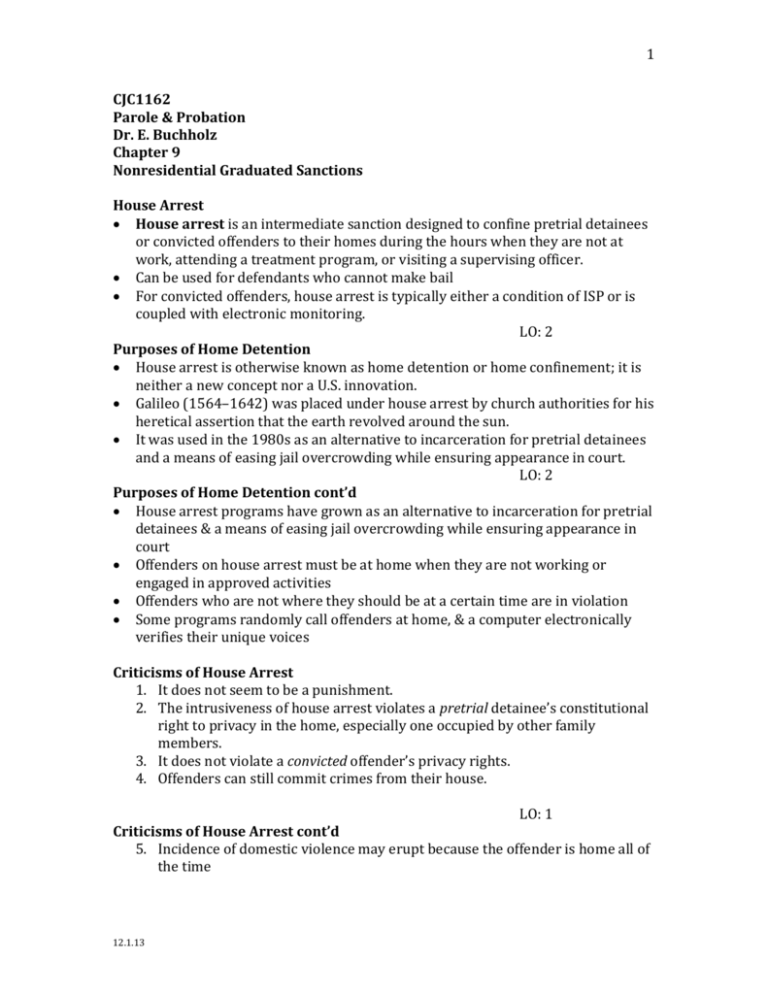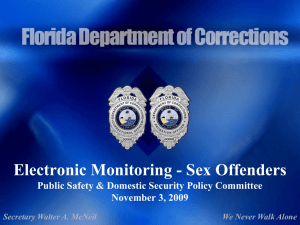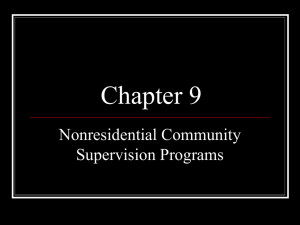Ch.9 - MDC Faculty Home Pages
advertisement

1 CJC1162 Parole & Probation Dr. E. Buchholz Chapter 9 Nonresidential Graduated Sanctions House Arrest House arrest is an intermediate sanction designed to confine pretrial detainees or convicted offenders to their homes during the hours when they are not at work, attending a treatment program, or visiting a supervising officer. Can be used for defendants who cannot make bail For convicted offenders, house arrest is typically either a condition of ISP or is coupled with electronic monitoring. LO: 2 Purposes of Home Detention House arrest is otherwise known as home detention or home confinement; it is neither a new concept nor a U.S. innovation. Galileo (1564–1642) was placed under house arrest by church authorities for his heretical assertion that the earth revolved around the sun. It was used in the 1980s as an alternative to incarceration for pretrial detainees and a means of easing jail overcrowding while ensuring appearance in court. LO: 2 Purposes of Home Detention cont’d House arrest programs have grown as an alternative to incarceration for pretrial detainees & a means of easing jail overcrowding while ensuring appearance in court Offenders on house arrest must be at home when they are not working or engaged in approved activities Offenders who are not where they should be at a certain time are in violation Some programs randomly call offenders at home, & a computer electronically verifies their unique voices Criticisms of House Arrest 1. It does not seem to be a punishment. 2. The intrusiveness of house arrest violates a pretrial detainee’s constitutional right to privacy in the home, especially one occupied by other family members. 3. It does not violate a convicted offender’s privacy rights. 4. Offenders can still commit crimes from their house. LO: 1 Criticisms of House Arrest cont’d 5. Incidence of domestic violence may erupt because the offender is home all of the time 12.1.13 2 6. Considerable discipline is needed to comply with house arrest, making it unsuitable for many offenders Offenders on house arrest are twice as likely as regular parolees to have their parole revoked for a technical violation Failure rates and absconding rates compared with other pretrial programs for state offenders, are similar. On a positive note, house arrest allows pretrial defendants the chance to keep working and supporting their families without interruption caused by incarceration. LO: 2 Electronic Monitoring Electronic monitoring (EM) is a correctional technology used in intensive supervision probation, specialized parole, day reporting centers, and house arrest. EM can also be used for defendants who have not yet been convicted but require an elevated level of supervision while out on bond or pretrial supervision. LO: 2 Electronic Monitoring Home-based electronic monitoring o An intermittent or continuous radio frequency signal from a landline telephone or wireless unit into a receiver (ankle bracelet) LO: 2 History of Electronic Monitoring Robert Schwitzgebel at the University of California developed electronic monitoring technology in the 1960s during the deinstitutionalization movement of the mentally ill. The idea for use of EM devices in the criminal justice system was inspired by New Mexico judge Jack Love, who saw how the comic book character Spiderman was tracked by a wrist transmitter. LO: 1 History of Radio Frequency EM cont’d A wrist EM device was first used in 1983 for DUI & white-collar offenders Problems with Early EM Early electronic monitoring programs required that offenders had a landline telephone, discriminating against the poor Home-bound EM systems were not able to track offenders once they left their home There was no guarantee that the probation office was actually communicating with the “correct” person. 12.1.13 3 Certain areas in a home could not receive transmissions LO: 3 EM Expenses A single home-based EM transmitter and receiver system costs $50,000 for the equipment plus operating costs. Offenders help subsidize the operating costs by paying a monthly fee of $10 per day. The cost effectiveness of electronic monitoring depends on the custody level of the comparison group and how revocations are handled. LO: 3 Global Positioning Systems GPS uses 24 military satellites that orbit the earth and 5 ground control stations to pinpoint locations anywhere in the world using data coordinates. Offenders wear a permanent ankle bracelet, which carries a one piece transmitter & a GPS receiver containing a microprocessor GPS is authorized in nearly every state, but most states mandate its use for sex offenders LO: 1 Active and Passive Active GPS systems transmit the data through wireless networks like a cell phone. Active systems are also known as real-time units, because data can be transmitted often with a short lag time. In a passive GPS system, the daytime tracking data is temporarily stored and downloaded at night through a land-line phone while the offender is sleeping. LO: 1 GPS Zones The microprocessor inside the receiver also allows the probation officer to use software to program in exclusion zones and/or inclusion zones. An exclusion zone would be the residence and workplace of an identified victim. An inclusion zone would be the offender’s place of employment or school. LO: 2 GPS Zones cont’d If an offender enters an exclusion zone or an inclusion zone at the wrong time, or tampers with the system, the supervising officer is alerted Electronic monitoring techniques for various offender risk levels Limitations of GPS Loss of GPS signal: unreliable signal in rural areas, in some locations in urban areas, & cell phone dead spots Short battery lives Cost Offenders can remove device with specialized tools 12.1.13 4 Costs of GPS The primary drawback is cost. Real-time active GPS systems cost $10-$16 for the equipment, while passive GPS costs $5 per day. It is still less expensive than building new facilities. LO: 3 How Do People Feel About EM & GPS? Concerns that widespread use will widen the net Ethical concerns that private companies are profiting from the new technology The general public seems supportive Supervising officers support its use but note that it has increased their paperwork & it increases probability of violations How Do People Feel About EM & GPS? Offenders prefer it over jail but report a sense of loss of control & shame wearing the device So far, courts have upheld its use as constitutional Empirical Evaluations of EM & GPS Completion rates for convicted nonviolent federal offenders: 89%; for federal pretrial detainees: 77% 6 months is a typical threshold for how long offenders should be under EM or GPS Comparisons of EM offenders with those on regular supervision found similar recidivism rates, but it does have a positive impact on how offenders act while under supervision Empirical Evaluations of EM & GPS A California study of high risk sex offenders found GPS parolees had about the same recidivism rates as similar offenders on traditional parole release California’s Realignment Program On October 1, 2011, the system shifted the responsibility of monitoring nonserious, non-violent parolees to the counties. The counties, under California’s realignment effort, shoulder prison overflow and develop individualized approaches to monitoring for both pretrial detainees and parolees in reentry. California’s Realignment Program Due to realignment measures that punish parole violators with county jail, house arrest, or electronic monitoring, those that break parole are never sent back to state prison. These efforts have saved bed space and trail-blazed for “smart-on-crimers” seeking to evolve the state’s efforts against recidivism. 12.1.13 5 Gender Differences with EM Men report receiving support from a significant other while on EM, but women on EM report less support & more stress EM & GPS hold promise as technology improves & costs are reduced, but success depends on using it with the correct offenders Gender Differences with EM Issues remain about whether the technology can create a false sense of security & whether we have unrealistic expectations about its effectiveness Day Reporting Centers Day reporting centers (DRCs) are a type of outpatient program based on a 3 phase levels system where offenders report daily for a variety of treatment programs, itinerary, and random drug testing. DRCs are like a “one-stop shop” with all the resources and educational programs in one place. LO: 2 DRCs Low staff/offender ratio & often open extended hours Can be used in many ways: for pretrial detainees, a reentry program for new parolees, an increased sanction for probation/parole violators DRCs Day centers have been popular in England and Wales since the 1970s and began to appear in the United States in 1985. Connecticut and Massachusetts were among the first states to adopt day reporting centers. Most DRC programs exist in states that do not have ISP as a sentencing option. Many DRCs accept high risk offenders They range in size from small to large centers. Treatment vs. Supervision Oriented DRCs Some DRCs emphasize treatment; others emphasize supervision Treatment oriented DRCs offer a wide range of services, classes, & counseling Supervision oriented DRCs ensure compliance with the rules & monitor whether offenders are following their planned schedules with EM, phone contact, & infacility time Treatment vs. Supervision Oriented DRCs Average DRC sentence is 6 months DRCs are more costly than traditional probation/parole & intensive supervision, but less than residential treatment & incarceration 12.1.13 6 Evaluations of DRCs DRCs accept higher risk offenders than many other programs & place much responsibility on the offender They have lower completion rates compared to those for other communitybased programs Termination rates are higher for service-oriented programs than supervision-oriented ones Evaluations of DRCs Termination rates are higher for programs longer than 6 months Illinois study found lower recidivism for offenders who spent 70 or more days in a DRC compared to those who spent only 10 days in a DRC Commonwealth v. Wegley, 829 A.2d 1148 (Pa. 2003) The Pennsylvania Supreme Court ruled that an individual on electronic monitoring & house arrest is in official detention. When Jonathan Wegley removed the EM device from his leg & left his residence, he could be charged & convicted of the crime of escape under state law for unlawful flight from house arrest. Tracking Sex Offenders with GPS California tracks more sex offenders with GPS than any other state. Officers more time with computer tracking & far less time in the field. Officers are flooded with data. Recently introduced procedures will use private GPS companies to screen alerts & contact officials when necessary, freeing them up for more personal contacts. Tracking Sex Offenders with GPS Phillip Garrido kidnapped Jaycee Dugard and held her captive for 18 years. Investigations show that California parole officials ignored hundreds of alerts that showed Garrido, a convicted sex offender, had violated his curfew & tampered with his EM device. http://www.huffingtonpost.com/2011/05/26/jaycee-dugard-caseinspir_n_867739.html 12.1.13








